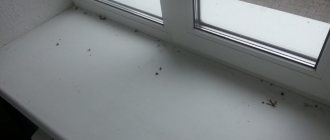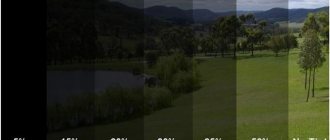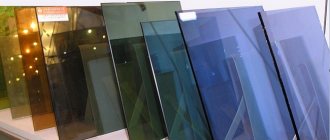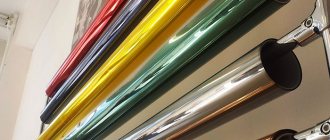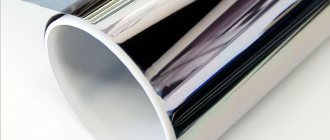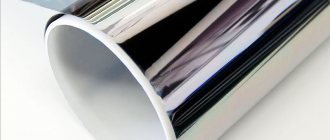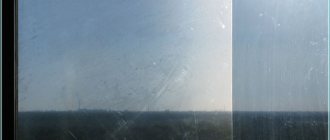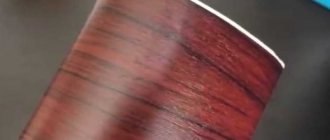Innovative technologies
Thanks to the latest materials and advanced technology involved in the manufacture of the tint coating, a special structure of such films is created, which includes several layers. It is this that plays the main role in shaping the characteristics of a particular film, as well as the window that has undergone the tinting process. Tinting film for glass surfaces is divided into types, depending on its physical and optical qualities.
Affordable and reliable options
The main types of window coverings include security and solar control films, as well as architectural, tinting and decorative coatings. Correctly installed film can give glass surfaces completely new qualities and an ideal appearance. For this reason, at present, window films and all kinds of tinting coatings have become widespread and widely accepted.
Today, in the design of the exterior design of buildings, a trend has emerged that involves a large number of glass surfaces. However, elements made of glass represent the most vulnerable area of any building. The optimal solution to protect glass surfaces is to apply a protective impact-resistant film. This coating will make windows, doors and partitions reliable and safe, shatter-proof and resistant to shock and damage.
Despite its small thickness, the protective film makes the windows much stronger. A film with a thickness ranging from 0.3 to 0.38 mm can protect glass even from being hit by a stone, strong wind or fire. Thus, applying a high-quality tint film also requires additional investment in safety.
In accordance with GOST R 51136-2008, the impact resistance of window film according to protection classes is:
CLASS A1 - P2A - thickness 300 microns - impact energy 141 J, withstands a three-time drop of a ball weighing 4 kg from a height of 3.5 m;
CLASS A2 - P3A - thickness 400 microns - impact energy 262 J, withstands a three-time drop of a ball weighing 4 kg from a height of 6.5 m;
CLASS A3 - P4A - thickness 600 microns - impact energy 382 J, withstands a three-time drop of a ball weighing 4 kg from a height of 9.5 m.
Impact Film Test
Armor film protection classes
- Class A1. This film has a thickness of 300 microns and is used for office premises, small shops and other small establishments.
- Class A2. The film thickness is 400 microns and is used in protected areas: large retail premises, art galleries and museums.
- Class A3. This film is 600 microns thick and has the highest protection class. The use of such film is usually justified on government buildings, bank branches and exhibition centers.
- Class SB2D - its thickness is 200 microns. The peculiarity of such protection is its anti-fragmentation properties. It is installed to protect people from sharp fragments formed when glass is damaged: this is convenient in cases of business centers, shops and facilities where many people are regularly present.
Benefits of booking large windows
Modern architecture includes quite a lot of glass elements: often these are large display windows, facade glazing, and other elements that occupy a fairly impressive area. The glass used to create such structures does not always meet high requirements for strength and safety, so they are easy to break, which can be exploited by attackers.
Armored film for window glass will help protect windows and glass structures from illegal entry, minor scratches and serious cracks. It preserves the glass, making it more durable, and does not affect the transparency of the structure unless it has a specially designed darkening. In addition, the film makes the glass itself much safer: if it does break, the fragments will remain hanging on the film and will not fall on the floor of a residential or office space, which will not only make cleaning much easier, but can also protect the people in the rooms.
The film can be applied to any glass, even if it was installed a long time ago. Manufacturers offer a large selection of products that differ in transparency, thickness, and color. Films may have different technical characteristics and vary significantly in price based on them.
What is impact-resistant film on glass by protection class?
The protective film is a multi-layer structure made of sensitive adhesive and an elastic polyester layer. To install such glass there is no need to replace existing glass, since the film is installed directly on the existing glazing.
This film is divided into several protection classes: A1 (P2A), A2 (P3A) and A3 (P4A), but we will only talk about the latter, as the most protected. The thickness of such a film is more than 600 microns, and it can withstand a blow of 382 J (in other words, glass protected by such a system will easily survive a 3-fold drop of a 4-kilogram ball from a height of almost 10 meters).
A3 (P4A) film is installed in order to maximally protect the premises from possible burglary, therefore it is recommended for use in museums, shopping centers and other buildings in which material assets are stored. However, even if the glass is broken, shards will not remain around and cause unwanted injuries.
Adhesive tape
An adhesive layer is applied to the protective film on one side; the use of third-party glue is not required. That is why the film is often called “self-adhesive”
.
Initially, the adhesive layer is covered with a “liner” (technological thin film). To adhere to glass, the liner is gradually removed from the film.
To ensure that the film does not immediately stick to the glass when touched and can be leveled and placed on the glass, a liquid composition is used that neutralizes the glue. After placing the film, the composition is squeezed out from under the film with scrapers and the adhesive layer attaches the film to the glass.
Complete drying (the process of gluing and evaporating the neutralizing layer through the film) can take 2-4 weeks, but after 8-12 hours the film is securely attached to the glass.
Advantages of film with protection class A3 (P4A)
Armor film of class A3 (P4A) not only protects the glass from breaking, it has a number of advantages that conventional tinting cannot:
- resistance to mechanical stress: film strength is 24 kg/mm2. As a rule, every second is valuable to any intruder, and therefore, having realized that the window is well protected, thieves usually retreat.
- reducing the risk of injury from shrapnel. If there are children at home, then such protection is simply necessary. If the glass breaks or cracks, the film will hold its parts until it can be disposed of.
What advantages does the product have?
Reserving double-glazed windows will first of all prevent your property from theft. The criminal will not be able to get into the premises by breaking a window. The method also has other advantages:
- Unlike roller shutters or grilles, films do not spoil the appearance of windows; they are completely invisible, do not attract attention and do not create inconvenience during use.
- The material can resist fire, which increases the protective capabilities of windows.
- Application to glass is not difficult, even if you do it yourself.
- The films protect well from sunlight, so the furniture in the room will not fade and the wallpaper will not change color. Many indoor plants will feel more comfortable, the owners will not suffer from the heat in the summer, and the lighting of the rooms will not be affected.
- The film will significantly reduce the noise level, since even a thick double-glazed window still has sound conductivity through the glass.
- The decorative nature of the material allows you to refine the window and disguise it as stained glass if you use a colored version.
- The material protects well from splinters.
- When using even the thinnest film, the strength of glass increases 4 times. If part of the surface is damaged, it is quite difficult to break the window completely; to do this, the attacker must spend a lot of time, which will attract the attention of others.
- The film can also be useful for glass repair. If a small crack has formed on it, and you do not want to change the double-glazed window, you can apply a film that will not only hermetically seal the resulting damage, but will also prevent the crack from growing.
Protective films are a smart solution that allows you to reliably protect them from mechanical damage without spoiling the visual appeal of your windows.
Ordering a glazing reservation at A-Solar
Do you need to armor glass with A1, A2 or A3 film? The assortment includes materials of all classes. Go to the website catalog, select a product option that suits your purposes, and place an order by phone or online.
Please note: the process of gluing the shockproof layer is more complex than in the case of athermal or decorative tinting. Therefore, to reliably book your glazing, immediately order professional installation from A-Solar. Our team of installers will complete the installation quickly and efficiently, even when covering a large area.
You can find out the cost of all goods, as well as related services, by downloading the price list on the company’s website.
Protective (reservation) film for windows
Sticker process
The application technology comes down to the following steps:
- Preliminary cutting of film with the necessary margin
- Cleaning glass from serious stains
- Cleaning glass with a washing-neutralizing solution
- Applying a washing-neutralizing solution to glass
- Preliminary placement of the film on the glass
- Partial removal of the liner from one edge of the film, temporary fastening of this edge to the glass
- Removing the liner from under the film, simultaneously with wetting the exposed adhesive layer with a washing and cleaning solution
- Fixing the film on the glass by squeezing the cleaning solution from under the film using forcing and scrapers
- Trimming the edges of the film
How to “book” glass yourself
Fordka's glass was broken for the third time in a year. Before installation, they decided to protect the new glass with an “armor” film. This film is similar to the tint film, but several times thicker, and most importantly, it is transparent. The film evenly distributes the impact over the entire area of the glass and it becomes more difficult to break such glass.
So let's start from the beginning.
Place the glass on a non-scratch surface and thoroughly clean the inside of the glass with glass cleaner and a lint-free cloth. Dirt and lint remaining under the film are forever.
Apply the film to the glass. The film consists of a main adhesive layer and a transparent protective backing. Before cutting, make sure to place the film with the backing side down. It is convenient to fix the film with masking tape.
We cut the film so that about a centimeter extends beyond the glass.
We are preparing a special product to temporarily neutralize the glue. The product consists of water from Mosvodokanal and 10-20 percent liquid soap or shampoo. The brand of soap is not of fundamental importance; it is advisable to take it with a minimum of additives in order to reduce the likelihood of a chemical reaction with the film adhesive. Pour the resulting mixture into a garden sprayer.
Remove the protective backing from the film. We hold the film itself with our fingertips by the edges, which will not touch the glass. Spray the film and glass generously. Apply the film to the glass. The film is prevented from gluing by the mixture remaining between it and the glass, so the film can be moved relative to the glass.
Wrap the spatula in a napkin. Plastic spatula, special, for tinting work. A napkin is needed to facilitate the sliding of the spatula over the film. In principle, you can use a plastic card instead of a spatula.
We begin to expel the soap solution from under the film with a spatula. We move from the center to the edges, leaving no bubbles. In the photo: on the left - before using a spatula, on the right - after.
Dirt and dust that gets on the glass prevents the film from sticking tightly, and bubbles form. In the photo - next to the metal strip. I don’t know how to fight it; I didn’t allow them to form in the visible area during the work process.
After finishing the work with a spatula, you can dry the film with a hairdryer. Hint; the heated film stretches well, which allows you to paste over surfaces curved in two planes. It’s true that it’s better to use an industrial hair dryer for this – it has a higher temperature and a thinner jet. Let the glue dry for 60 minutes.
At this time, we prepare a special tool for cutting the film. The photo shows a prototype knife with a pencil lead case glued to it (I had nothing on hand). The glued film should be 4-5 mm smaller than the size of the glass, so as not to touch the velvets and not peel off from contact with them. When gluing the film on a machine, it is pre-cut to the required size. We will have to pervert using stationery as a guide.
We cut the film along the border of the glass. We hold the knife at 45 degrees, hold the film on the glass with a spatula (the left hand is occupied with the camera).
Using a homemade special tool, we cut the film indented from the edge.
The cost of “reserving” one glass amounted to 250 rubles. per p.m. films. The width of the roll is 1,500 mm, there is still left for all sorts of perversions like headlight protection (instead of polishing the headlights it is easier to change the film). It also adheres well to the body, protecting it from chips. The cost of “booking” in the tinting studio is 1,250 rubles. Pricing is clear as day.
Now the glass can be broken as early as the fourth blow and the cubes of fragments do not scatter throughout the cabin


